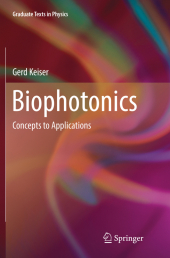 Neuerscheinungen 2018Stand: 2020-02-01 |
Schnellsuche
ISBN/Stichwort/Autor
|
Herderstraße 10
10625 Berlin
Tel.: 030 315 714 16
Fax 030 315 714 14
info@buchspektrum.de |

Gerd Keiser
Biophotonics
Concepts to Applications
Softcover reprint of the original 1st ed. 2016. 2018. xxiii, 345 S. 102 SW-Abb., 86 Farbabb., 100 Farbt
Verlag/Jahr: SPRINGER, BERLIN; SPRINGER SINGAPORE; SPRINGER 2018
ISBN: 9811092893 (9811092893)
Neue ISBN: 978-9811092893 (9789811092893)
Preis und Lieferzeit: Bitte klicken
This book introduces senior-level and postgraduate students to the principles and applications of biophotonics. It also serves as a valuable reference resource or as a short-course textbook for practicing physicians, clinicians, biomedical researchers, healthcare professionals, and biomedical engineers and technicians dealing with the design, development, and application of photonics components and instrumentation to biophotonics issues. The topics include the fundamentals of optics and photonics, the optical properties of biological tissues, light-tissue interactions, microscopy for visualizing tissue components, spectroscopy for optically analyzing the properties of tissue, and optical biomedical imaging. It also describes tools and techniques such as laser and LED optical sources, photodetectors, optical fibers, bioluminescent probes for labeling cells, optical-based biosensors, surface plasmon resonance, and lab-on-a-chip technologies. Among the applications are optical coherence tomography (OCT), optical imaging modalities, photodynamic therapy (PDT), photobiostimulation or low-level light therapy (LLLT), diverse microscopic and spectroscopic techniques, tissue characterization, laser tissue ablation, optical trapping, and optogenetics. Worked examples further explain the material and how it can be applied to practical designs, and the homework problems help test readers´ understanding of the text.
Introduction to Biophotonics.- Fundamentals of Light: Basics of optics and photonics; Refractive index; Polarization; Coherence.- Optical Sources and Photodetectors: Lasers, laser diodes, LEDs; photodiodes, CCDs, photomultiplier tubes.- Optical Fibers for Biophotonics Applications.- Principles of Light-Tissue Interactions: Absorption, reflection, scattering; Fluorescence.- Light-Tissue Interaction Effects.- Microscopy: Visualization methods for different microscopes.- Spectroscopy: Fluorescence spectroscopy; Raman spectroscopy.- Optical Imaging: Optical coherence tomography; Endoscopy.- Tissue Engineering: laser surgery, treat skin and dental diseases.- Low-Level Light Therapy (LLLT).- Optical Manipulation: optical tweezers, optical trapping, cell sorting.- Probes and Sensors: Optical fiber devices; Surface plasmon resonance.- Nanophotonics: biocompatible quantum dots; high-resolution microscopy.- Biochips/Lab-on-a-Chip: compact integrated biosensors for enhanced optical intensity and spectral measurements in real time.
"Biophotomcs is a good textbook and will undoubtedly be a valuable lecture Supplement in an advanced undergraduate or graduate-level course. ... the material is pertinent and is presented clearly enough to provide a springboard for further study" (Arjun Yodh, Physics Today, February, 2018)


